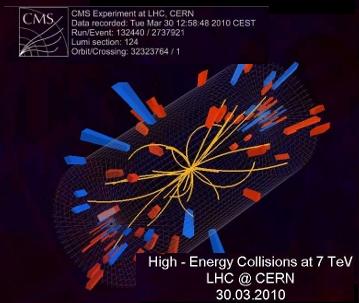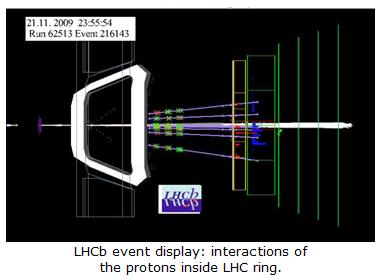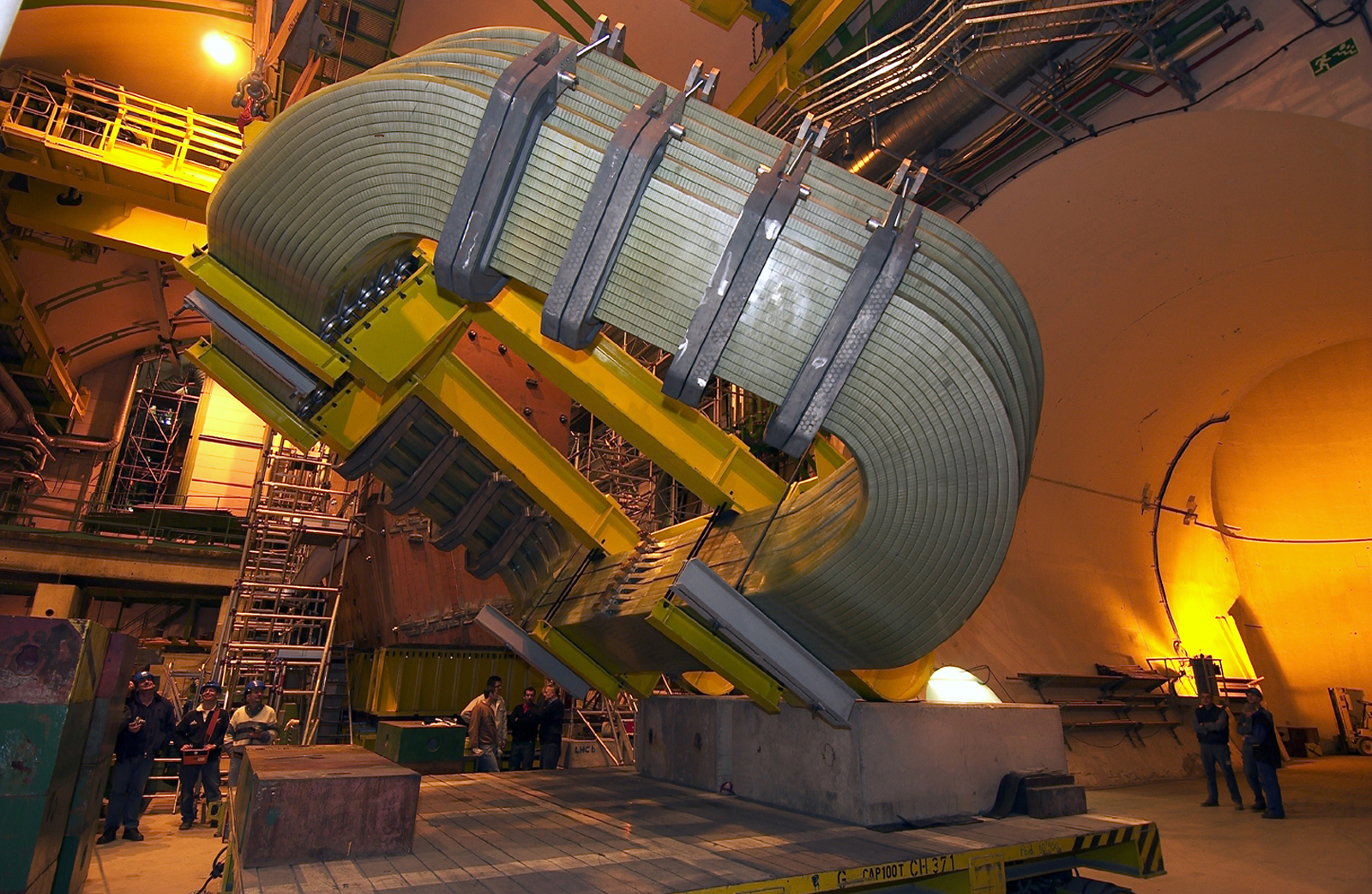Taking a closer look at LHC
The so-called “Beam Lifetime” (ζ) is the time interval after which the intensity of the beam has reached 1/e of its initial value (e is Euler’s number). ag
We are going to estimate this value by considering any of the more important situations wich can cause decreasing of the number of protons
Keep in mind that we will consider the parameters corresponding to the initial start-up of the LHC, so they should be updated, if necessary, with the values corresponding to the specific moment we wish to evaluate.
First we consider the collisions among protons in the interaction points. The total proton-proton cross section at 7 TeV is approximately 110 mbarns (milibarns)
(with 1 barn = 10-24 cm2= 10-28 m2).

The total collision rate at nominal luminosity is:
Nevent/s = L·σ event
1034 x [(110 x10-3) x 10-24] ~ 109 collisions/second
With 2808 bunches:
109/2808 ⇒ 3.6·105 collisions per bunch and second.
We can consider these collisions as a proton “decay” process with a probability, λ :
Since initially the total number of protons per bunch is Np0 ~ 1.15·1011 protons:
λ = 3.6·05/1.15·1011 ⇒ λ = 3·10-6 s-1
This value represents the probability that one proton collide with an opposing proton per second.
So, the variation of the number of protons is given by:
dNp/dt = – λ × Np
So,
Np(t) = Np0 × e-λ× t
where Np(t) is the number of protons per bunch as a function of time and Np0 the initial number of protons per bunch.
If we now solve the last equation with Np(t) /Np0 = 1/e and t = ζ we get:
1/e = e-λ× ζ
and finally,
ζ =1/λ
With λ = 3·10-6 s-1 , we obtain:
ζ = 3·105 s (~ 80 h)
So, by considering only protons collisions in the interactions point the Beam Lifetime would be over 80 hours.
A second important process which decreases the number of protons is the the inelastic scattering produced by proton-gas collisions (see Ideal Gases Equation section). Elastic interactions are not considered because in this process the kinetic energy of the proton is conserved, and magnetic multipoles act to correct these deviations by focussing the bunch.
The main gases are H2, CH4, CO, CO2, H2O and nobles gases, but we will consider that all molecules are H2 (In fact, for calculation the rest of molecules "are converted into" H2equivalent, by introducing corrector parameters).

For proton-hydrogen nucleus collision (p-H1) at 7 TeV, the inelastic scattering cross-section is ~ 40 mb; therefore, for proton-hydrogen molecule (p-H2) this value is σ ~ 80 mb (cross-section, σ, for proton-gas collisions represents a hypothetical area which describes the probability of a proton being scattered by a hydrogen molecule. See more ...).
σ ~ 80 mb ⇒ σ ~ 80·10-3 x 10-28 ⇒ σ ~ 8·10-30 m2
For this calculation, we consider the 2.45-km-long LHC arcs, where the gas density (ρm) has significant importance ( see Ideal Gases Equation section).
In this case ρm ~ 1.4·1015 molecules/m3
The distance of the eight 2.45-km-long is d = 8 × 2450 ⇒ d ~ 2·104 m
Then, for a single bunch (Np ~ 1011 protons) circulating, the number (Nlap) of bunch-gas interactions per lap over a distance d is:
Nlap ~ σ× ρm × Np × d
Then,
Nlap ~ 8·10-30 × 1.4·1015 × 1.15·1011 × 2·104
Nlap ~ 26 collisions/lap per bunch
Since bunches do 11245 laps per second (f ), the rate of bunch-gas interactions (Rint) is:
Rint = Nlap × f
Rint ~ 26 × 11245 ~ 2.9·105 (290 kHz)
So we have around 3·105 lost protons per bunch in a second when beams begin to circulate around the LHC.
We can consider again this situation as a proton “decay” process with a probability, λ :
λ = (2.9·105)/(1.15·1011)
λ = 2.5·10-6 s-1
This value represents the probability that any proton collide against any gas molecule per second.
Using again,
ζ =1/λ
we finally obtain:
ζ = 4·105 s (~ 110 h)
So, taking only into account protons-gas collisions the Beam Lifetime would be over 110 hours.
By considering the both two process together, the Beam Life time will be:
1/ζ = 1/ζ1 + 1/ζ2
1/ζ ~ 1/80 + 1/110
ζ ~ 45 h
A third group of processes is related to mechanisms such as limited efficiency of the correction and focalization systems,Coulomb scattering of protons travelling together (Touschek effect included), or travelling in differents bunches when crossing in interaction points, or operating errors, also contribute in decreasing the Beam Lifetime.
The number of beam protons lost per second due to these processes is approximatente 2,5·106 protons per second and per bunch when beams begin to circulate around the LHC..
We can consider again this situation as a proton “decay” process with a probability, λ :
λ = (2.5·106)/(1.15·1011)
λ = 2.2·10-5 s-1
This value represents the probability of losing one proton per second per bunch.
Using again,
ζ =1/λ
we finally obtain:
ζ = 4,5·104 s (~ 13 h)
Taking this third type of processes the Beam Lifetime would be over 13 hours.
If we consider all the processes we have just studied at the same time, the Beam Lifetime will be:
1/ζ = + 1/ζ1 + 1/ζ2 + 1/ζ3
1/ζ ~ 1/80 + 1/110 + 1/13
ζ ~ 10 h
Taking all phenomena into account, the Beam Lifetime for the LHC is finally around 10 hours.
Again, we recall that these calculations have been performed with the nominal starting parameters of the LHC.
|
AUTHORS Xabier Cid Vidal, PhD in experimental Particle Physics for Santiago University (USC). Research Fellow in experimental Particle Physics at CERN from January 2013 to Decembre 2015. He was until 2022 linked to the Department of Particle Physics of the USC as a "Juan de La Cierva", "Ramon y Cajal" fellow (Spanish Postdoctoral Senior Grants), and Associate Professor. Since 2023 is Senior Lecturer in that Department.(ORCID). Ramon Cid Manzano, until his retirement in 2020 was secondary school Physics Teacher at IES de SAR (Santiago - Spain), and part-time Lecturer (Profesor Asociado) in Faculty of Education at the University of Santiago (Spain). He has a Degree in Physics and a Degree in Chemistry, and he is PhD for Santiago University (USC) (ORCID). |
CERN CERN Experimental Physics Department CERN and the Environment |
LHC |
IMPORTANT NOTICE
For the bibliography used when writing this Section please go to the References Section
© Xabier Cid Vidal & Ramon Cid - rcid@lhc-closer.es | SANTIAGO (SPAIN) |



